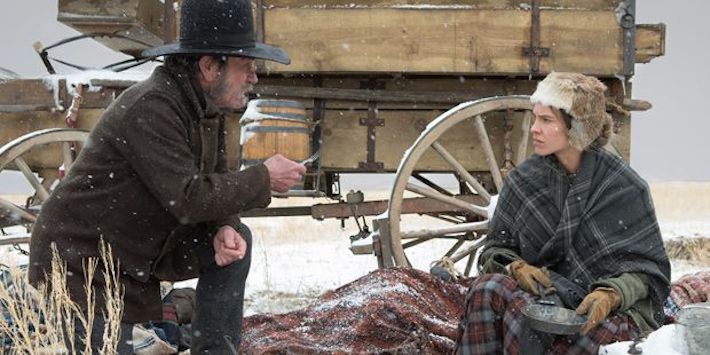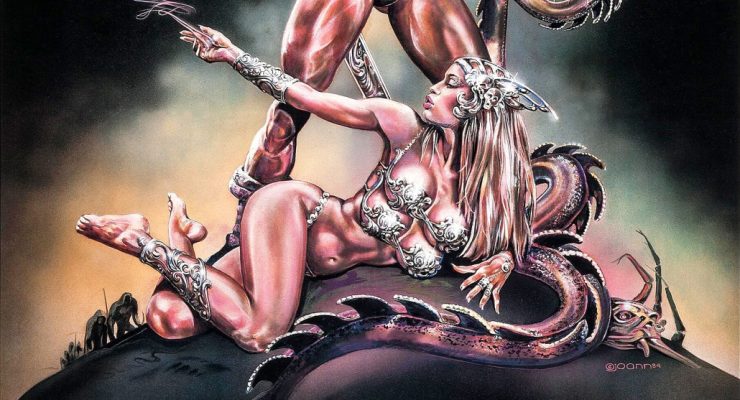The Homesman (2014)
Directed by Tommy Lee Jones
Starring Tommy Lee Jones, Hilary Swank, Grace Gummer, Miranda Otto, Sonja Richter, John Lithgow, Hailee Steinfield, Jesse Plemons, Tim Blake Nelson, William Fitchner, Meryl Streep
SYNOPSIS:
Ably independent yet desperate to nurture a family, Mary Bee Cuddy agrees to transport three women maddened by trauma across the country, enlisting the help of an aged, stubborn drifter along the way.

Despite what Tommy Lee Jones might want you to think, his new film, The Homesman, is definitely a western. And thank goodness, for the genre has been sorely lacking in reinforcements in recent years. It’s long been a favourite genre of mine, from Peckinpah to The Coen Brothers, Leone to Tarantino, but if you were to sieve through, say, the last ten years for decent entries (excluding hybrids like Cowboys & Aliens or an Aussie western like The Proposition), what have you got? True Grit? Django Unchained? Possibly The Three Burials Of Melquiedes Estrada? Aside from them, you’d have to go all the way back to Unforgiven in ’92 to find the last truly great western of our time. It’s sad that it’s not a genre modern audiences tend to warm to, so we can only be thankful to advocates like Tommy Lee Jones for keeping the traditional American western alive with beautiful and brilliant films like The Homesman.
Adapted from Glendon Swarthout’s novel, the film follows the story of Mary Bee Cuddy (Swank) in her quest to transport three women, all of whom have lost their minds, across the country, enlisting the help of an apparent lowlife squatter (Lee Jones) on the way. What’s immediately striking about the film is just how scrumptious the whole thing looks. Westerns inherently lend themselves to a unique beauty often not achievable in other genres with their haunting, majestic landscapes and rich colour palettes, but that’s not to say work mustn’t be put in to achieve the best results. Shot by Rodrigo Prieto, who’s worked in the genre before on Brokeback Mountain, The Homesman’s visuals are completely subduing and chocolatey, yet equally vibrant and striking, drawing us into the frame whether sweeping through a valley or tucked away in a candle-lit cabin. It’s one of those films that you enjoy watching as much for physicality of just looking at the screen as you do for what’s happening on it.
An intelligent script gives foundation to two terrific, multi-layered lead performances from Swank and Lee Jones, which, being at the centre of pretty much everything, offer solidification to proceedings. They’re helped enormously by richly drawn characters who grow more and more compelling the longer we’re with them. George Briggs is a sort of atypical western hero; when he tries things they don’t always work. He’s good with his mouth and makes us think he knows what he’s doing, but often comes off second best. Over time it becomes apparent that his real strength lies not in guns and violence, but in his character, and it takes a strong, moralistic woman to unwrap him. That woman, Mary Bee, is an equally compelling figure in her quest to gain what she perceives as value to her life, and it’s an incredibly tragic story when viewed from her perspective. From she herself describing her life as “unusually lonely” to her desperate attempts to marry herself off and mother children, only hearts made of stone won’t feel sympathy for her. Enormous credit must go to Swank for bringing such an endearing truthfulness to the role.
It seems impossible not to draw comparisons to others in the genre when discussing westerns, and The Homesman is certainly no exception. There’s an element of Two Mules For Sister Sarah in the devout woman/stubborn gun-slinger on the road together relationship, and the idea of a gruff, curmudgeonly old man agreeing to help a woman in need, who in turn reveals hidden truths and emotions within him, is clearly True Grit-inflected. In terms of how the central relationship plays out – and it’s possibly the Tommy Lee Jones connection at work – The Homesman also shares much in common with Ron Howard’s lesser-known The Missing. Something about the way in which the two of them rub off each other reminded me a lot of Cate Blanchett’s disapproval of her companion (in that case, her father), as well as her similar agenda and ideals. But so impressive about The Homesman is that it derives elements of all of these films while still working entirely as its own thing. You can’t help but feel that in years to come we’ll be talking about other films paying homage to this. It just has that timeless, unassuming, Unforgiven-like sensibility about it.
The film, too, contains something which is all too in cinema rare these days: a genuinely shocking moment. Not like a jump in a horror movie, but a moment that completely surprises you, upsets you, and takes you off guard with just how horrifyingly real it is. It’s a moment responsible for a distinct shift in tone and narrative, yet probably more responsible for a shift in the audience’s appreciation of the story that’s being told. It’s upsetting and distressing, yet entirely admirable in what it represents, and while the had novel obviously already gone there, the film executes it perfectly.
In considering all the elements – which also includes a nice score from hit-and-miss composer Marco Beltrami – what becomes apparent is that The Homesman is truly fine filmmaking. Is it one of the all-time greats? Perhaps not, but perhaps that’s not important. It’s a subduing, reflective, emotional and intelligent film that demonstrates just how good the genre can be when it’s good, and we desperately need more of it. He may be a prickly character real life, but Tommy Lee Jones is doing something very right.
Flickering Myth Rating – Film: ★ ★ ★ ★ / Movie: ★ ★ ★ ★
Edward Gardiner










